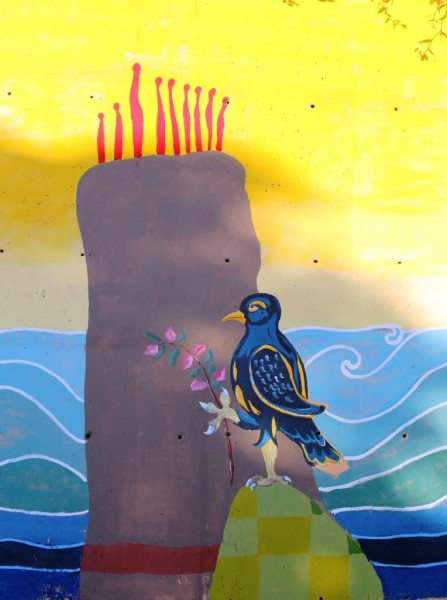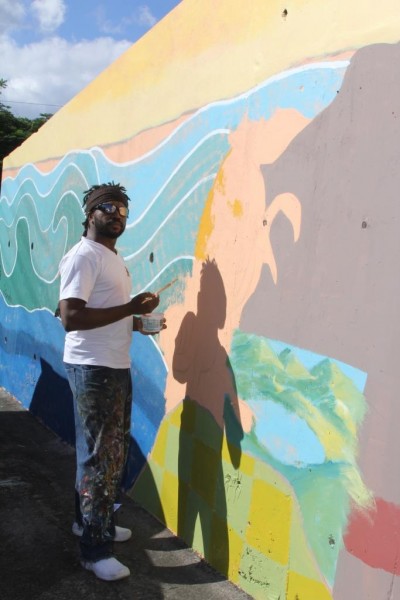
Grenada's Minister of Tourism, Civil Aviation and Culture, the Hon. Alexandra Otway-Noel, visits some of the artists working on the “Paradise Lost” mural – Suelin Low Chow Tung, Xandra Shaw and Victoria Slinger. Photo courtesy the artists; used with permission.
When it comes to climate change, better late than never. Inspired by the global marches against climate change [1]which took place on September 21 [2], a group of artists and activists in Grenada decided to paint a mural to raise local awareness about this pressing issue.
Climate change [3] and the threat of global warming have, many feel, been ignored for long enough by world leaders who, primarily for economic reasons, have lacked the political will needed to tackle the problem and commit to a changeover to clean energy rather than continuing to extract the earth's diminishing fossil fuels. The Climate Summit [4] that took place at the United Nations headquarters in New York on September 23 was intended to catalyse promises from member countries and turn them into action.
Global Voices spoke to Victoria Slinger and Suelin Low Chow Tung about Grenada's climate change mural and what they hoped it would accomplish. The painting's design elements, conceptualised by Low Chow Tung, include elements such as the population of the island (crowded onto the highest points), Amerindian petroglyphs (in recognition of the country's indigenous people [5]), and fishing boats without fish (a foreboding of one of the possible effects of climate change).
Taking inspiration from the country's Coat of Arms [6], the mural also contains ships (representing the country's yachting and tourism industry), a gold cross (as recognition of a God consciousness), a lion (as a symbol of strength and unwavering determination to face challenges), Grand Etang Lake [7] as well as cocoa nutmeg and banana trees, a star (symbolic of hope), and the flora [8] and fauna [9] of the island, including seven roses, which represent Grenada's seven parishes [10]. They called it Paradise Lost, a reference to 17th-century English poet John Milton's epic poem [11], which chronicles the fall of Man.

The Grenada Dove with a spray of Bouganvillea; a nod to the country's national bird and flower. Photo courtesy the artists; used with permission.
Global Voices (GV): How did you get the idea to paint a mural instead of organizing a march, as happened in other countries, including Trinidad and Tobago [12]?
Victoria Slinger (VS): This was my doing mainly. I am interested in art and also wanted to do something that would be more fun to participate in. There are many people here who are concerned about climate change, but there are too many who are not – mainly because they do not have the exposure to the information and do not know enough science not to be swayed by the nay sayers who just baffle them with bullshit. I felt a mural being permanent would be able to reach more people. Also, a Sunday is no time to do a march in Grenada. St. George's [the capital] is a ghost town and nobody is going to come out to see a lot of people with banners protesting. I did not believe there was anywhere suitable to do [a march].
GV: Tell us about the design for the mural and its dimensions.
VS: The wall is between 6 and 12 feet high and 60 feet long, if we use all of it. That has not yet been decided, but it will be at the very least 6 feet high and 40 feet long. Suelin, as the designer, will decide what fits her design. It is the retaining wall at the back of the GSPCA [Grenada Society for the Prevention of Cruelty to Animals] car park so many people will see it. I hope, if it gets enough publicity here, people will come specially to see it.
Suelin Low Chow Tung (SLCT): The mural's elements are taken from our Coat of Arms and they speak to the negative impact to the country by rising sea levels due to climate change.

Kai and Anja Niermann and Lene Kilde in process, working on the mural. Photo courtesy the artists; used with permission.
GV: What inspired this particular design concept?
VS: My feeling is that to some extent it should show what could be lost to us forever if something is not done about climate change. A large increase in sea level will be devastating to our main towns, St. George's [13], Grenville [14] and Gouyave [15] and will destroy tourism, the main earner for the island. Every way you look at it, it will be a disaster.
GV: How many people participated in the event? What type of support did you receive?
SLCT: The participants [16] in the project were Victoria Slinger, Suelin Low Chew Tung, Anja and Kai Niermann, Xandra and Kirby Shaw, visiting Norwegian sculptor Lene Kilde [17] and her daughter, and visiting Haitian artist Prensnelo [18]. We received paint and supplies from St George’s University, Sissons Paints Grenada Limited, Insurance Consultants of Grenada Ltd, Ace Hardware/Bryden and Minors, Ramdhanny’s Hardware, Sherwin Williams, and Renwick, Thompson and Co.

Haitian artist Prensnelo paints the armadillo of the Grenada climate change mural. Photo courtesy the artists; used with permission.
GV: Do you feel Caribbean residents are as conscious of the issue as they should be?
VS: Never mind the Caribbean, I don't believe the average resident of any of the developing countries (in which category I include USA for this purpose) are as conscious of the issue as they should be. My feeling is that the main reason is they do not have the science background to understand it properly and to realise that after a certain point it will not be possible to reverse, and then it will just be a matter of time till the earth can no longer support most of life as we know it. It will be back to bacteria as far as I am concerned. Therefore they are too easily satisfied by the flawed science being fed to them by the fossil fuel, mining and other interests who don't want to act.
The Caribbean [19] region, which is primarily made up of small island states and low-lying continental areas with fragile economics, is particularly susceptible to the adverse effects of climate change. Initiatives such at the People's Mural are critical to helping the population understand the importance of climate change.